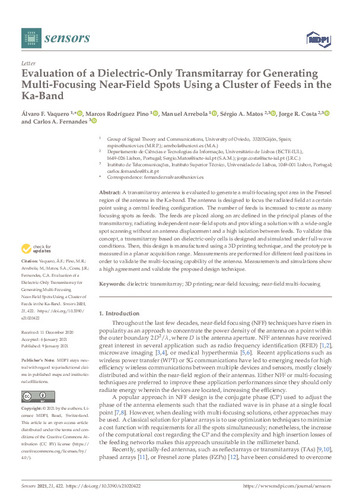Evaluation of a dielectric-only transmitarray for generating multi-focusing near-field spots using a cluster of feeds in the Ka-band
Palabra(s) clave:
Dielectric transmitarray
3D printing
near-field focusing
near-field multi-focusing
Fecha de publicación:
Versión del editor:
Citación:
Resumen:
A transmitarray antenna is evaluated to generate a multi-focusing spot area in the Fresnel region of the antenna in the Ka-band. The antenna is designed to focus the radiated field at a certain point using a central feeding configuration. The number of feeds is increased to create as many focusing spots as feeds. The feeds are placed along an arc defined in the principal planes of the transmitarray, radiating independent near-field spots and providing a solution with a wide-angle spot scanning without an antenna displacement and a high isolation between feeds. To validate this concept, a transmitarray based on dielectric-only cells is designed and simulated under full-wave conditions. Then, this design is manufactured using a 3D printing technique, and the prototype is measured in a planar acquisition range. Measurements are performed for different feed positions in order to validate the multi-focusing capability of the antenna. Measurements and simulations show a high agreement and validate the proposed design technique.
A transmitarray antenna is evaluated to generate a multi-focusing spot area in the Fresnel region of the antenna in the Ka-band. The antenna is designed to focus the radiated field at a certain point using a central feeding configuration. The number of feeds is increased to create as many focusing spots as feeds. The feeds are placed along an arc defined in the principal planes of the transmitarray, radiating independent near-field spots and providing a solution with a wide-angle spot scanning without an antenna displacement and a high isolation between feeds. To validate this concept, a transmitarray based on dielectric-only cells is designed and simulated under full-wave conditions. Then, this design is manufactured using a 3D printing technique, and the prototype is measured in a planar acquisition range. Measurements are performed for different feed positions in order to validate the multi-focusing capability of the antenna. Measurements and simulations show a high agreement and validate the proposed design technique.
DOI:
Patrocinado por:
This research was supported in part by the Ministerio de Ciencia, Innovación y Universidades under Project TEC2017-86619-R (ARTEINE), by the Gobierno del Principado de Asturias and Fondo Europeo de Desarrollo Regional (FEDER) under Project GRUPIN-IDI/2018/000191, Vicerrectorado de Investigación of Universidad de Oviedo under Plan de Apoyo y Promoción de la Investigación under project PAPI-20-PF-15, and in part by the COST (European Cooperation in Science and Technology) under COST Action TD1301, MiMed.
Colecciones
Ficheros en el ítem





